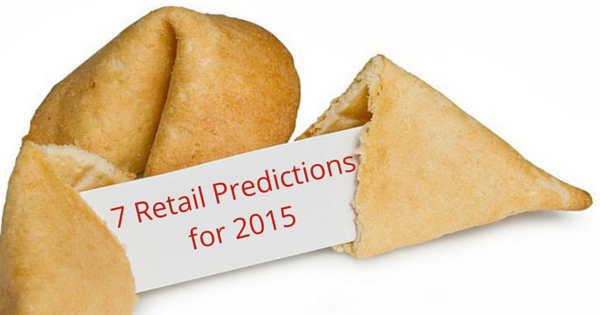Each new year brings new retail trends, which change the way companies do business. In these retail predictions, we look at emerging trends and technologies that we expect will be most significant in 2015. You’ll discover how each trend will affect the customer experience and get insights on how retailers can improve their customers’ shopping journeys.
[Tweet “Check out these #Retail Predictions for 2015”]
[xyz-ihs snippet=”TOFU2-Retail-Technology-button”]
1) Mobile Shopping Expands
Having a shopping function on a mobile website is great, but it’s not nearly enough anymore. Mobile websites can’t only facilitate online shopping in 2015, they have to encourage it now as well.
Did you know that in 2014, 24% of mobile internet users were purchasing goods from their devices? That number will definitely increase this year (not least because of social shopping – see #2 on our list) and retailers need to make sure they’re not left behind.
Consumers expect fast, flowing, straightforward mobile use that will make online shopping easy. We expect retailers to deliver on this – those who haven’t already.
2) Social Shopping Expands
For a long time, sites like Facebook, Twitter and Instagram have been used to market retail products to great effect. The time has finally come for those social media sites to become shopping places. 2015 will see the introduction of more and more “Buy it Now” options.
The sites themselves will also continue to expand, bringing other applications – such as Pinterest and Viber – into the fold. As consumers share products and create collections of products they like, retailers will strive to make a connection between “liking” a product and purchasing it.
Keep your eyes peeled for Facebook and Twitter’s “Buy” buttons and Instagram’s “Like2Buy” platform powered by Curalate. Just be careful with those double-taps from now on.
3) Third Party Technology Expands
By 2017, three times as many retailers as now will explicitly pin their customer and operations strategies on 3rd platform technologies, including just a handful of examples:
- Mobile apps – see #1 on our list
- Beacon technology – allowing retailers to engage customers with location-based, personalized, targeted, in-store promotions
- Fitting room technology – creating increased conversion for apparel retailers and better customer service for shoppers
- Cloud-based POS systems
4) Big Data Plays Friendlier
 Big data for the sake of big data will become less important than zeroing in on the data that actually impacts the bottom line. Retail marketers must consider how to curate better experiences for consumers, and data can help to do so.
Big data for the sake of big data will become less important than zeroing in on the data that actually impacts the bottom line. Retail marketers must consider how to curate better experiences for consumers, and data can help to do so.
The more a company knows about its consumer, the more it can customize its marketing and advertising strategies to increase sales. Retailers are at times slow to adopt insights realized from their data and analytics. Expect to see more attention paid to data as this will fuel growth and allow for faster business decisions based on reliable metrics.
In 2015, data will be more accessible than ever, and retailers will have the technology to analyze that data in order to maximize investments, fuel growth, and enhance the customer experience.
5) Loyalty Programs Become More Than Points-for-Purchase
Loyalty programs will continue to be a major factor, but retailers will begin to use something other than “points-for-purchases” to appeal to their customers.
Retailers will need to be more inventive than ever to excite and incentivize consumers, driving them to make more purchases; loyalty will need to become hyper-personal and/or creative.
In addition to rewarding shoppers for their purchases, retailers will reward consumers for engaging with the brand or for participating in activities the company supports. Retailers will also begin to be smarter about when they introduce loyalty programs as well as what they offer.
6) Online – Mobile Expands in All Directions
In addition to mobile shopping (see #1), expect to see more:
- loyalty apps
- mobile services
- mobile payment options
The more useful and interesting apps are, the more likely customers are to use them, which helps not only to generate sales but to solidify the brand.
7) Offline – Brick and Mortar is Still Very Relevant
We may be in the middle of the digital age, but that works both ways in retail. Despite the ever-growing popularity of mobile shopping, we don’t expect physical stores to die out any time soon.
We’re starting to see online retailers cross the void and enter the realm of the physical. Bonobos, a successful men’s clothing eCommerce site, has opened “Guideshops” across the USA that let shoppers try on their online discoveries before parting with their cash. If we needed any more evidence that people still want a traditional shopping experience, stores like this are what we’d present to the jury. Bonobos, and retailers like it, are beginning to acknowledge that eCommerce cannot fully emulate good old fashioned brick and mortar.
Brick and mortar offers an alternative experience that provides localized service, luxurious fitting rooms, and a few treats on the side. Consumers deserve convenience, but they deserve a full and traditional shopping experience should they want that too. We predict 2015 will be the year retailers give it to them.
[xyz-ihs snippet=”TOFU2-Retail-Technology-button”]
Summary
2014 was a big year for retailers, but 2015 will be even bigger. All of the trends listed above point to one simple thing – the customer experience. In 2015, retailers will utilize mobile technology, data analytics, and social media to not only drive sales and increase their market shares, but also reward and incentivize their customers to gain their loyalty and increase sales.
[xyz-ihs snippet=”Try-It-On-CTA”]
